Meredith Allard's Blog, page 7
January 16, 2024
Writing Inspiration: Facing the Fear of First Drafts
 No One Likes Writing First Drafts
No One Likes Writing First DraftsWhile I will always love writing in the Loving Husband and Hembry Castle worlds, my creativity has been pulling me in other directions lately. I’ve started the academic research that has been on my mind for some time now, and I’m branching out in my fiction.
I’ve been writing and publishing for more than two decades, and I’ve been feeling the need to make some creative changes.
I currently have a new project that lights me on fire, but that means I am now languishing in first draft hell. You would think that because I’m working on my 15th book that my first draft would be easier this time, but it isn’t. Not even close.
It’s not like this idea hasn’t had time to percolate. I spent a year daydreaming through this book, but it’s still a chore, putting one word after to the other until I have a complete draft, something to work with, a self-created slab of clay I can mold into the story I see so clearly in my mind.
I Definitely Don’t Like Writing First DraftsThe truth is, I hate writing first drafts of anything—essays, short stories, scholarly articles, novels, e-mails. This post. I have, I’m not embarrassed to admit, rewritten grocery lists because I didn’t like the way I organized them.
When I’m teaching writing I always know what to say to my students to help them deal with first-draft phobias or writer’s block, but do I listen to my own advice? Rarely. At least not until I’m so annoyed I have to remind myself what I already know about writing. Doctor, heal thyself.
Writers Love Excuses Not To WriteI’m still falling victim to old writers’ stand-bys, otherwise known as Excuses. Trust me, it’s not hard to find plenty of Excuses to keep from working.
These are the days when I dust and vacuum instead of writing, you know, not just regular maintenance house cleaning but the vacuuming-behind-the-sofa-where-people-will-never-see kind of cleaning. The days when I brush my cats instead of writing that first draft, or worse, talk to my cats instead of writing that first draft. There are grocery stores to shop in, movies to see, lunches to do, friends to visit, books to read, research to complete, and classes to teach.
I’m even going to the gym instead of writing, and I hate going to the gym. At this precise moment, I’m writing this post instead of working on that first draft. The list of Excuses can be endless.
In an attempt to remind myself what I already know about first drafts, I decided to write a few posts about the advice I’ve given to my writing students over nearly two decades to help them rise above such obstacles. The advice has been helpful for my students, and quite frankly, I need the reminding.
Are you like me, languishing before the computer screen, pulling your own hair, looking for ways to get that first draft done?
I’m beginning a new series called “How To Write a First Draft.” Whether you are a new writer or someone like me who has been writing for decades, I hope you will find some useful information. The first draft posts are coming soon.
December 12, 2023
Happy Holidays: Christmas Eve at Hembry Castle

I hope everyone has been having a joyous holiday season. I love this time of year with the multi-colored twinkle lights, the Christmas movies, and the holiday spirit everywhere. I’ve been enjoying a quiet Hanukkah, and I’m looking forward to a restful Winter Holiday, which can’t begin soon enough.
As I’ve been enjoying my peppermint hot chocolates and winter blend teas, I thought I’d share one of my favorite chapters from Christmas at Hembry Castle, perfectly entitled “Christmas Eve at Hembry Castle.”
Happy holidays and a peaceful new year to everyone.
~Meredith
* * * * *
Downstairs at Hembry Castle was all a bustle as it had been for weeks. Poor Mrs. Graham was dusted from her cap to her boots in thick white flour. The powder ingrained itself in every hair, every line on her face, every flourish on her apron, every crevice on the folds of her work dress. No matter how many times a day she washed, ten minutes later she was once again covered in chalky white. If it wasn’t “Pies!” it was “Cakes!” and if it wasn’t “Cakes!” it was “Puddings!” and if it wasn’t “Puddings!” it was “Pies!”
Everyone with flexible limbs who was not of the family or their guests was put to constant use throughout the day and night of Christmas Eve. This maid was needed to fix this green velvet holiday dress with the white fur collar, adjusting the bustle just so. That footman was needed to carry this gentleman’s brown leather hunting bag to the stables. A constant hum of rushed footsteps carrying potato balls and Father Christmas shortbread and ham rolls and chestnut stuffing and roast turkey and “Pies!” of every variety could be heard up and down the stairs. The rhythmic stamping of dancing and skipping around the tree echoed in the kitchen. Footmen carried silver bowls of hot punch, mulled wine, and Madeira eggnog, so many bowls that the servants wondered how much are they drinking up there? Quite a lot from the boisterous laughter, the barely restrained shouting, and the off-key carol singing. The servants knew they would have their time to celebrate soon enough, with plenty of food, drink, music, poems, bon-bons, carol singing, and dancing of their own.
Mrs. Ellis smiled while directing traffic. She couldn’t help herself. The holidays were her favorite time of year no matter the headache of seeing a hundred things done at once. She looked toward the door of the servants’ entrance and remembered the previous Christmas. Last year that door had been left open to the cold and the snow, as it would certainly be again this year. The younger servants loved to slide down the snowy mound behind the courtyard, screaming with eggnog-induced laughter. She remembered the flush of red excitement on Edward’s face as he and Lady Daphne spent the day dancing and exchanging presents. Is that the day they fell in love, Mrs. Ellis wondered? She had a feeling it had started before then, but she was certain that was the day they both knew what was happening.
Oh! She would wring her grandson’s neck, that stubborn mule of a boy, that is, if she ever saw him again. He wouldn’t talk to her, or Lady Daphne, or even the Earl of Staton. But what she would say to him as soon as he showed his face again! And why was that harebrained boy hiding anyway? He was acting like he had to confess to being the Rugeley Poisoner. Yes, he had been let go from Fergusonandwately, but Mrs. Ellis didn’t see that as being such a terrible thing. They had taken advantage of her Neddie, she was certain of it, paying him a pittance when his stories were so very popular. Was Edward even still in London? Mrs. Ellis didn’t know. She thought of Lady Daphne upstairs, a smile on her lips, a sadness in her eyes, and wished it were last year again.
Upstairs, Lady Daphne, her father, the Earl of Staton, and her grandmother, the Countess of Staton, were the epitome of good English hosts. While hundreds of guests filed into the castle, bringing brisk, cold air and dropping fresh, slippery snow onto the rugs in the front hall, the family presided over the festivities with a genteel decorum that would be expected of Lord Staton’s family. During the daylight hours there was hunting for the gentlemen and any ladies who wished to accompany them. For the ladies and some gentlemen who were not inclined to blood sport, which included Lord Staton and Lady Daphne, there were plenty of games of charades and line dances and carol singing to keep everyone merry on Christmas Eve.
After the sky grew dark and the hunters were home from the hills, Hembry Castle was all alight. The gaslight sconces were turned on bright while tapered candles added warmth to every nook and crevice. The postmaster’s wife, Mrs. Ebberts, regaled everyone with lively Christmas carols on the piano, accompanied by her daughter, Miss Ebberts, who did her best to sing along. The mother and daughter duo were the very picture of the holiday season in their red toile dresses with red fur sleeves and small white riding hats, which they insisted on wearing indoors. The fires were kept low since the guests, the rum punch, the singing, and the line dances brought their own heat.
Daphne chatted with Miss Ebberts, wishing to thank the youngish woman for her gracious holiday entertainments. Miss Ebberts was beside herself speaking to Lady Daphne Meriwether. At the fifth “Oh dear! I can’t believe I’m talking to you, my lady. I’m all afluttered!” Daphne smiled, thanked Miss Ebberts once again, then excused herself. She walked into the wide central room where guests danced the Queen’s Waltz. Two couples put their right hands in, traveled forward, put their left hands in, traveled forward. Daphne watched as they skipped and peeled. Last Christmas she and Edward had danced the day away together. They were so happy. What had happened? Daphne didn’t know. At the moment she would settle for a simple conversation with him. She had decided that the engagement was definitely off. She hadn’t admitted it yet, not out loud, not to anyone, not even to her father who had always been her most trusted of confidants.
Of course, he had guessed, Papa. He had asked her several times, “When is Edward coming to celebrate Christmas with us?” or “Why haven’t you set a wedding date? Are you and Edward having problems between you, Daphne?” And Daphne would insist no, absolutely not, never. Edward and I love each other. Edward and I are getting married. Her father would nod, his eyes small because he understood what she wouldn’t say. But since she had not confided in him, he would not intrude. It’s better this way, Daphne thought. Papa has enough troubles of his own. He wants to fix everything for everyone, which is one of the many reasons I love him so.
Daphne passed the gilded mirror on the wall in the drawing room where the titled guests gathered to toast each other’s health again and again. She caught a glimpse of herself, her hair adorned with green lace ribbons and stacked high on her head, her festive dress made especially for this day, deep green velvet adorned with white rosettes, the back tapering to her bustle and falling in ripples to the top of her white boots. When she had the dress made she thought she and Edward might marry sometime this Christmas season. She had thought so many things.
Yes, her heart was broken, but her heart had been broken before. When her mother died, and then her grandfather, she was shattered every which way, but she mended, and she survived. Although the pain of Edward’s loss was physical, as if she were poked by knives, she would survive this too. For now, she must smile. She must smile and chat and watch others enjoy the delicious bites that Mrs. Graham had prepared. As Daphne turned to leave she nodded at the woman who caught her eye, some Lady Whatever dripping in rubies and emeralds, but Daphne escaped before having to speak to anyone.
Free from the prying eyes of the titled whoevers, Daphne headed upstairs for a few moments of peace. She stopped at the sound of a woman singing “Silent Night.” This wasn’t one of Miss Ebberts’ well intentioned attempts, but rather something plaintive and ultimately beautiful. Who was singing? Daphne didn’t know. She only knew that the high pitched dulcet tones filled her with deep longing.
Silent night, holy night
All is calm, all is bright
Round yon Virgin, Mother and Child
Holy infant so tender and mild
Sleep in heavenly peace
Sleep in heavenly peace
Daphne dabbed her eyes with the back of her hand. She turned toward the staircase and saw Mr. Ellis supervising the footmen as they delivered platters with food and drink. Daphne steeled herself. The Ellises were Edward’s grandparents and they were employed by her father. She would continue to see them all day, every day, until they retired. They were good people, the Ellises. She loved having them around, and certainly Hembry Castle could never function without them. When Mr. Ellis saw her, he nodded, once, but there was much feeling in the gesture. It took every ounce of strength Daphne had to hold her anguish inside until she escaped into the sanctuary of her bedroom.
It wasn’t dark this Christmas Eve, not yet. The sun was only beginning to set and the sky blushed pink and white as the delicate snowflakes fell, leaving soft pillows on the ground. The holiday revelries inside Hembry Castle grew more raucous the later the time grew. Several guests left for other celebrations. For some, the number of festivities they attended were a badge of honor. Others were quite happy to continue the holiday entertainments in the hallowed halls of Hembry Castle.
It was a dangerous hour for ghosts to be about, this in-between time, but he was a ghost on a mission. The snow fell faster, leaving a fresh white blanket weighing down the bare-branched trees, stretching across the grounds, covering the very castle itself in pristine radiance. The ghost, immune to the icy air, numb as he was, lingered near the servants’ courtyard, close but not so close. He was near enough to see the younger servants dancing to an out of tune violin playing “Ding Dong, Merrily on High” while others slipped and slid down the snowy embankment. The servants were so caught up in their merrymaking they weren’t likely to notice him. He was an unobtrusive ghost, after all. But he couldn’t take a chance that he might be seen. He stepped behind the wall of the courtyard and waited.
“So?” he heard from the other side of the wall.
“So?”
“Are you ready?”
“This is the moment I’ve been waiting for,” the ghost said. “I’m ready.”
The hours passed. The night grew later and darker and the grounds grew whiter. It would be rude to yawn in front of his guests, so Frederick, Lord Staton, helped himself to some hot water and the last scoop of darjeeling at the side table where guests had been feasting on small dishes of quails eggs, truffle potatoes, fried smelts, roast turkey, and of course Mrs. Graham’s delicious pies. He could never get enough of them. He wasn’t hungry himself, Frederick, but he enjoyed watching his guests savor every delectable dish. Mrs. Graham had worked so very hard, after all. He sipped his tea, but instead of a burst of energy he felt lethargic until the sight of a fresh snowfall brightened him. He had always loved the snow in winter, and especially he had always loved Christmas at Hembry Castle. Yes, this year was different when last year had been so joyful. But this too shall pass, Frederick thought. Everything, both good and bad, changes with time and we must make the best of it, good and bad. We learn what we need to learn from each experience, good and bad, and we carry on, doing the best we can at every turn.
Frederick stared through the window at the deepening gray haze coming down from the north, which meant the snow was likely to continue until morning. He startled when a loud “Your lordship!” came from behind. He turned to see Mrs. Ellis pressing a silver tray with a letter in his direction.
“Excuse me, my lord. I’m sorry to disturb you.”
“You’re not disturbing me, Mrs. Ellis. Not at all.”
“I’m afraid you were looking rather contemplative.”
Soft heels of a genteel country dance echoed into the room.
“I’m not certain one can be contemplative on such a day.” Frederick nodded at the silver tray. “Are you the butler here now?”
“Mr. Ellis is busy downstairs so I told him you wouldn’t mind if I brought this. It seemed urgent.”
She pressed the tray closer to Frederick. He sighed, but he took the letter and the opener, sliced the envelope, and read the contents. He read once, read twice, read a third time just to be certain, then slid the letter back into the envelope and into his breast pocket.
“Who sent this?” he asked.
“I couldn’t say, my lord. I was told it was left outside the door, and as you can see the envelope is addressed to you.”
Mrs. Ellis waited while he took the letter from his pocket to read once more.
“I’m afraid I must leave at once, Mrs. Ellis.”
“But it’s Christmas Eve, your lordship. Your guests are here.”
“They’re so busy they won’t notice if I nip out for a bit.”
Frederick glanced around to be certain that indeed his guests would not notice his temporary absence. When no one seemed to pay him the slightest attention he disappeared upstairs to change and consider his next steps.
Mrs. Ellis was about to return downstairs to see if Mrs. Graham was still conscious. The housekeeper was stopped by an inquisitive stare from her husband, who had appeared as if out of the air, as he so often did.
“Where is his lordship going on Christmas Eve?” Mr. Ellis asked.
“I’m sure I don’t know. It seemed important, though.”
“Should I ask why you brought him that letter instead of me?”
“No, Mr. Ellis. You shouldn’t.”
“Very well.” Again, the inquisitive stare, this time over the top of his spectacles. “This is highly unusual, I must say. His lordship would never leave his guests at his own Christmas Eve celebration.”
“I’m sure it was nothing more than some complaint from her ladyship, who is currently holding state in the drawing room, her ear trumpet pressed to the side of her head as she listens to the gossip from Lady Someone.”
Mr. Ellis nearly laughed aloud but caught himself. Mrs. Ellis shooed her husband away.
“Go on. There’s still so much to see to for the rest of the night.”
Mr. Ellis nodded, gave his wife one more hard stare, and moved on.
November 14, 2023
The Hembry Castle Box Set On Sale Now
 Happy Autumn, Everyone!
Happy Autumn, Everyone!It took a little longer to cool down in Las Vegas this year. Even as I write this it’s about 70 degrees Fahrenheit outside, though at least it’s cool enough for the trees to begin to turn their reds, rusts, and yellows, which I look forward to seeing every year.
It has also been cool enough for me to begin baking again. I find that baking is a seasonal activity here in Southern Nevada where it gets so hot during the summer. I’ve found a new favorite pumpkin recipe: pumpkin cake in a mug (with chocolate chips, of course). It takes less than ten minutes to throw together, and it cooks in the microwave.
And Shadows Will Fall UpdateFor those of you looking for an And Shadows Will Fall update, I’m now looking forward to a Spring 2024 release. Some stories take longer to come to life, and And Shadows Will Fall is one of them. The pieces now fit nicely together, and I have a suspicion that James and Sarah fans will be pleasantly surprised. I’ll have more to say about that in the new year. I’ll be sure to let everyone know when the review copies for ASWF become available.
I’m Thankful This HolidayAs we head toward the Thanksgiving holiday in the U.S. next week, I wanted to say how grateful I am for the readers all over the world who continue to contact me about my stories, especially the Loving Husband Series. It is beyond my imaginings that after more than a decade, James and Sarah continue to find new fans.
 The Hembry Castle Box Set is On Sale
The Hembry Castle Box Set is On SaleI wanted to say thank you to my readers this holiday season by sharing the Hembry Castle Chronicles, both books, for 99 cents. If you enjoy Victorian era sweet romance, with a little Downton Abbey upstairs/downstairs storylines, and some mystery thrown in, I think you’ll enjoy the books. If you like lighthearted Christmas stories, then Christmas at Hembry Castle is definitely for you.
The box set is on sale until 12/31/23. If you’d like to know more about the box set, you can read more here.





I wish all of my American friends a Happy Thanksgiving. May the autumn holiday be everything you wish it to be.
October 12, 2023
Historical Recipe From Colonial America: Indian Pudding
 John Wentworth’s Favorite Food
John Wentworth’s Favorite FoodFans of Her Dear & Loving Husband know that when James Wentworth married Elizabeth Jones in December 1691, one of the foods James’ father John insisted on was Indian Pudding. As John tells Elizabeth, “You cannot end a meal without Indian Pudding.”
What Is Indian Pudding?If you’re not familiar with the term, you may know it better as Hasty Pudding, a simple dish from England of wheat flour boiled with milk or water until it had a custard-like texture.
According to “From the Kitchen” by Jan Longone, “We do know that the techniques used in making Indian or Hasty Puddings are age-old; gruels, pottages, porridges, frumenties, and puddings were made from the earliest times.”
In the American colonies, where European settlers learned about corn from Native Americans, cornmeal substituted for the flour. Early settlers called cornmeal “Indian flour.” Thus, Indian Pudding was born. Longone continues, “We also know that specific pudding recipes very similar to those for Indian Pudding appear in Early English cookbooks, but these use wheat flour, rye flour…in place of the corn meal. Further, there are records that various Indian tribes and civilizations in the New World were making some form of corn meal gruel or pudding, of times sweetened with honey or native berries.”
John Winthrop, Jr., son of the first governor of the Massachusetts Bay Colony, wrote to the Royal Society in London in 1662 to say this about Indian Pudding:
…this is to be boyled or Stued with a gentle fire, till it be tender, of a fitt consistence, as of Rice so boyled, into which Milke, or butter be put either with Sugar or without it, it is a food very pleasant…but it must be observed that it be very well boyled, the longer the better, some will let it be stuing the whole day: after it is Cold it groweth thicker, and it commonly Eaten by mixing a good Quantity of Milke amongst it…
In 1672, John Josselyn said this about Indian Pudding:
It is light of digestion, and the English make a kind of Loblolly of it to eat with Milk, which they call Sampe; they beat it in a Morter, and shift the flower out of it; the remainder they call Hominey, which they put into a Pot of two or three Gallons, with Water, and boyl it upon a gently Fire till it be like a Hasty Puden; thye put of this into Milk and so eat it.
Since the Wentworths are wealthy (John is a successful merchant), they season their Indian Pudding with any spices they wish. Those less financially fortunate would have eaten the cornmeal boiled in water or milk without any adornments.
Making Indian PuddingWhile I’m busy working on And Shadows Will Fall, I wanted to try some of the dishes the Wentworths would have eaten in the Massachusetts Bay Colony in the late 17th century. I remembered John Wentworth’s fondness for Indian Pudding and decided to try my hand at this old but much-beloved recipe.
As always, I use modern appliances and ingredients. For me, the point isn’t to cook the way they used to cook. I don’t see myself standing over an open hearth moving burning coals around with a shovel while pushing my heavy skirts back so they don’t catch fire. For me, the point is to taste the flavors from the past, and this was a chance for me to try John Wentworth’s favorite dish.
How To Make Indian PuddingI looked at several Indian Pudding recipes, and each was a little different. Some used different spices, some used cream instead of milk, and there were other changes as well. I chose this recipe from The Old Farmer’s Almanac for the basis for my Indian Pudding.
Ingredients4 cups whole milk
1/2 cup cornmeal
1/2 cup molasses
1/2 cup light brown sugar
1/4 stick of butter, softened
2 large eggs, beaten
1 teaspoon salt
2 teaspoons sugar
1/2 teaspoon ground ginger
1/2 teaspoon ground cinnamon
1/8 teaspoon nutmeg
 Everything I used to make the Indian PuddingDirections:
Everything I used to make the Indian PuddingDirections:Making the Indian Pudding was surprisingly easy.
Butter a 2-quart casserole dishBring milk to a simmer. I used a heavy pot and kept the stove on a low flame until the milk started to simmer and bubbles formed along the edges. Keep stirring and be careful not to let the milk burn. Burned milk will not allow for the tastiest Indian Pudding. Add the cornmeal to the milk and keep whisking until the cornmeal is smooth.Add the molasses and keep stirring until it is completely incorporated. Remove from the heat and add brown sugar, butter, eggs, salt, sugar, ginger, cinnamon, and nutmeg. Whisk until smooth. On a personal note, whenever I see amounts for spices like cinnamon or nutmeg, I usually add more. I guess my tastebuds like stronger spices, but the amounts listed in other people’s recipes are usually not enough for me. That’s why I love baking. I can do it the way I like. If you prefer less of a strong spice flavor, stick to the amounts listed. Pour the mixture into the buttered casserole dish and bake in a preheated 300 degree Fahrenheit oven for 2 to 2 1/2 hours depending on how hot your oven cooks. My oven cooks pretty hot so it was done in two hours. Ready to add the cornmeal to the simmering milk.
Ready to add the cornmeal to the simmering milk. With brown sugar, butter, beaten eggs, salt, sugar, ginger, cinnamon, and nutmeg.
With brown sugar, butter, beaten eggs, salt, sugar, ginger, cinnamon, and nutmeg. After I whisked all the ingredients together.
After I whisked all the ingredients together. It took two hours for the dark top and custard to form.
It took two hours for the dark top and custard to form. Ready to eat! You could add whipped cream, ice cream, or some traditional milk, but I thought it was fine on its own.
Ready to eat! You could add whipped cream, ice cream, or some traditional milk, but I thought it was fine on its own. When the pudding has browned on top and has a custard or pudding-like texture, it’s done.
I have to say I really liked the Indian Pudding. It tastes like autumn, and it has all the wonderful flavors I gravitate toward this time of year: cinnamon, nutmeg, and ginger. I saw recipes that added pumpkin, and if you’re a fan of cooking with pumpkin as I am, then I think that would be a great addition to this recipe.
It tastes the way you would expect it to taste: corn custard sweetened with molasses with the spices making the custard even better. I love baking with molasses, but if you’re not a fan you will probably not like Indian Pudding. The butter causes the bottom to caramelize, which is always an added bonus.
I could see myself making this again. In fact, it would make a great Thanksgiving side dish or dessert. This is a sweet and not a savory, so it would do better as a dessert in my opinion.
Now that I have tasted my own Indian Pudding, I can say along with John Wentworth, “You cannot end a meal without Indian Pudding.”
Enjoy!
References
Boeckmann, Catherine. “Indian Pudding.” The Old Farmer’s Almanac. https://www.almanac.com/recipe/indian.... Accessed 9 October 2023.
Josselyn, John. New England Rarities Discovered. London, 1672.
Longone, Jan. “From the Kitchen.” The American Magazine and Historical Chronicle, Volume 2, No. 1, Spring-Summer, 1986.
What’s Cooking America. “Indian Pudding–Hasty Pudding Recipe and History.” https://whatscookingamerica.net/histo.... Accessed 8 October 2023.
Winthrop, Jr., John. “Letter To the Royal Society in London.” New England Quarterly, Volume X, No. 1, p. 121-133, 1937.
Historical Recipes: Indian Pudding
 John Wentworth’s Favorite Food
John Wentworth’s Favorite FoodFans of Her Dear & Loving Husband know that when James Wentworth married Elizabeth Jones in December 1691, one of the foods James’ father John insisted on was Indian Pudding. As John tells Elizabeth, “You cannot end a meal without Indian Pudding.”
What Is Indian Pudding?If you’re not familiar with the term, you may know it better as Hasty Pudding, a simple dish from England of wheat flour boiled with milk or water until it had a custard-like texture.
According to “From the Kitchen” by Jan Longone, “We do know that the techniques used in making Indian or Hasty Puddings are age-old; gruels, pottages, porridges, frumenties, and puddings were made from the earliest times.”
In the American colonies, where European settlers learned about corn from Native Americans, cornmeal substituted for the flour. Early settlers called cornmeal “Indian flour.” Thus, Indian Pudding was born. Longone continues, “We also know that specific pudding recipes very similar to those for Indian Pudding appear in Early English cookbooks, but these use wheat flour, rye flour…in place of the corn meal. Further, there are records that various Indian tribes and civilizations in the New World were making some form of corn meal gruel or pudding, of times sweetened with honey or native berries.”
John Winthrop, Jr., son of the first governor of the Massachusetts Bay Colony, wrote to the Royal Society in London in 1662 to say this about Indian Pudding:
…this is to be boyled or Stued with a gentle fire, till it be tender, of a fitt consistence, as of Rice so boyled, into which Milke, or butter be put either with Sugar or without it, it is a food very pleasant…but it must be observed that it be very well boyled, the longer the better, some will let it be stuing the whole day: after it is Cold it groweth thicker, and it commonly Eaten by mixing a good Quantity of Milke amongst it…
In 1672, John Josselyn said this about Indian Pudding:
It is light of digestion, and the English make a kind of Loblolly of it to eat with Milk, which they call Sampe; they beat it in a Morter, and shift the flower out of it; the remainder they call Hominey, which they put into a Pot of two or three Gallons, with Water, and boyl it upon a gently Fire till it be like a Hasty Puden; thye put of this into Milk and so eat it.
Since the Wentworths are wealthy (John is a successful merchant), they season their Indian Pudding with any spices they wish. Those less financially fortunate would have eaten the cornmeal boiled in water or milk without any adornments.
Making Indian PuddingWhile I’m busy working on And Shadows Will Fall, I wanted to try some of the dishes the Wentworths would have eaten in the Massachusetts Bay Colony in the late 17th century. I remembered John Wentworth’s fondness for Indian Pudding and decided to try my hand at this old but much-beloved recipe.
As always, I use modern appliances and ingredients. For me, the point isn’t to cook the way they used to cook. I don’t see myself standing over an open hearth moving burning coals around with a shovel while pushing my heavy skirts back so they don’t catch fire. For me, the point is to taste the flavors from the past, and this was a chance for me to try John Wentworth’s favorite dish.
How To Make Indian PuddingI looked at several Indian Pudding recipes, and each was a little different. Some used different spices, some used cream instead of milk, and there were other changes as well. I chose this recipe from The Old Farmer’s Almanac for the basis for my Indian Pudding.
Ingredients4 cups whole milk
1/2 cup cornmeal
1/2 cup molasses
1/2 cup light brown sugar
1/4 stick of butter, softened
2 large eggs, beaten
1 teaspoon salt
2 teaspoons sugar
1/2 teaspoon ground ginger
1/2 teaspoon ground cinnamon
1/8 teaspoon nutmeg
 Everything I used to make the Indian PuddingDirections:
Everything I used to make the Indian PuddingDirections:Making the Indian Pudding was surprisingly easy.
Butter a 2-quart casserole dishBring milk to a simmer. I used a heavy pot and kept the stove on a low flame until the milk started to simmer and bubbles formed along the edges. Keep stirring and be careful not to let the milk burn. Burned milk will not allow for the tastiest Indian Pudding. Add the cornmeal to the milk and keep whisking until the cornmeal is smooth.Add the molasses and keep stirring until it is completely incorporated. Remove from the heat and add brown sugar, butter, eggs, salt, sugar, ginger, cinnamon, and nutmeg. Whisk until smooth. On a personal note, whenever I see amounts for spices like cinnamon or nutmeg, I usually add more. I guess my tastebuds like stronger spices, but the amounts listed in other people’s recipes are usually not enough for me. That’s why I love baking. I can do it the way I like. If you prefer less of a strong spice flavor, stick to the amounts listed. Pour the mixture into the buttered casserole dish and bake in a preheated 300 degree Fahrenheit oven for 2 to 2 1/2 hours depending on how hot your oven cooks. My oven cooks pretty hot so it was done in two hours. Ready to add the cornmeal to the simmering milk.
Ready to add the cornmeal to the simmering milk. With brown sugar, butter, beaten eggs, salt, sugar, ginger, cinnamon, and nutmeg.
With brown sugar, butter, beaten eggs, salt, sugar, ginger, cinnamon, and nutmeg. After I whisked all the ingredients together.
After I whisked all the ingredients together. It took two hours for the dark top and custard to form.
It took two hours for the dark top and custard to form. Ready to eat! You could add whipped cream, ice cream, or some traditional milk, but I thought it was fine on its own.
Ready to eat! You could add whipped cream, ice cream, or some traditional milk, but I thought it was fine on its own. When the pudding has browned on top and has a custard or pudding-like texture, it’s done.
I have to say I really liked the Indian Pudding. It tastes like autumn, and it has all the wonderful flavors I gravitate toward this time of year: cinnamon, nutmeg, and ginger. I saw recipes that added pumpkin, and if you’re a fan of cooking with pumpkin as I am, then I think that would be a great addition to this recipe.
It tastes the way you would expect it to taste: corn custard sweetened with molasses with the spices making the custard even better. I love baking with molasses, but if you’re not a fan you will probably not like Indian Pudding. The butter causes the bottom to caramelize, which is always an added bonus.
I could see myself making this again. In fact, it would make a great Thanksgiving side dish or dessert. This is a sweet and not a savory, so it would do better as a dessert in my opinion.
Now that I have tasted my own Indian Pudding, I can say along with John Wentworth, “You cannot end a meal without Indian Pudding.”
Enjoy!
References
Boeckmann, Catherine. “Indian Pudding.” The Old Farmer’s Almanac. https://www.almanac.com/recipe/indian.... Accessed 9 October 2023.
Josselyn, John. New England Rarities Discovered. London, 1672.
Longone, Jan. “From the Kitchen.” The American Magazine and Historical Chronicle, Volume 2, No. 1, Spring-Summer, 1986.
What’s Cooking America. “Indian Pudding–Hasty Pudding Recipe and History.” https://whatscookingamerica.net/histo.... Accessed 8 October 2023.
Winthrop, Jr., John. “Letter To the Royal Society in London.” New England Quarterly, Volume X, No. 1, p. 121-133, 1937.
October 3, 2023
10 Places To Visit In Salem, MA
 Visiting Salem, Massachusetts?
Visiting Salem, Massachusetts?The latest book in the Loving Husband Series, And Shadows Will Fall, is a final visit for James and Sarah Wentworth to the time that shaped so much of their lives–the Salem Witch Trials. Once again, I’m digging into my research from that era to bring the Wentworths’ story to life.
As we’re headed into the Halloween season, I thought I’d share a bit about my trip to Salem, Massachusetts. One of my favorite parts of researching historical fiction is traveling to the places I’m writing about.
I had a great time when I visited Salem, and here are the places I enjoyed the most.
The House of the Seven GablesYes, this is the house that inspired Nathaniel Hawthorne to write his novel. The house where Hawthorne was born was moved onto the land. I loved both houses. I loved the grounds and the gardens. I loved that it was so close to the seashore. I loved the black and white cat I saw roaming the grounds. I can see how the mystery of the house inspired a literary classic.
The Salem Witch Museum
The Salem Witch Museum in Salem, MA.
This is probably one of the most visited places in Salem, and the museum plays an important role in Her Dear and Loving Husband as James and Sarah get to know each other. The building itself is a church-style structure, and it was right across the street from Salem Common. The museum provides a good overview of the witch hunt hysteria that overtook Salem in 1692.
The Red Trolley CarThere’s a red trolley car for tourists that takes you all over Salem, showing the points of interest and explaining them. It’s a relaxing way to get to see the town and learn some tidbits of Salem information. When I was there the guide said that the name Salem likely comes from Jerusalem, Salem meaning peaceful. Salem in the Massachusetts Bay Colony in 1692 was anything but peaceful.
Salem State UniversityReaders of The Loving Husband Trilogy know that James and Sarah both work at the university, James as a professor of English (teaching night classes, of course) and Sarah is a librarian. I loved visiting the campus and seeing the students on their way to classes.
Pickering Wharf
The Friendship, which is docked near Pickering Wharf, where Olivia’s shop The Witches Lair is located.
Pickering Wharf really does exist! It’s a seaside village of shops and restaurants and I enjoyed my afternoon there eating lunch at Capn’s. There were several shops there owned by psychics, so I knew I had picked just the place for Olivia to have her own psychic shop, The Witches Lair.
The Burying PointI’m not usually a fan of graveyards, but the Burying Point was interesting because it’s the burying place of some of the judges of the Salem Witch Trials, including Nathaniel Hawthorne’s ancestor John Hathorne (author Hawthorne added the w to his name because he didn’t want to be too closely connected to his witch-hanging ancestor Hathorne).
The John Ward House and the Jonathan Corwin House

The John Ward House is part of the Peabody Essex Museum. It’s a replica of a house from the 1600s, and what do you know—it looks just like James’s house! It was an incredible feeling to be walking around Salem and see a house from my imagination standing there plain as day. I felt like Sarah did when she saw the house for the first time. If there are ever movies made of the Loving Husband Trilogy, I know where they can find James’s house!
A similar house is the Jonathan Corwin House, also known as Witch House. Corwin was one of the magistrates presiding over the Salem Witch Trials. His house is the only remaining structure with direct ties to the witch hunts.
Forest River Park/Pioneer VillagePioneer Village is the closest you can come to time travel in Salem. The docents dress in costumes from the 1600s, and there are replicas of the types of homes you would have seen in the area in the days of the earliest European settlements. Pioneer Village is located within Forest River Park, which is a beach with rocky shores and a grassy area for picnics. It was a wonderful place to pass the afternoon.
Rebecca Nurse HomesteadFor readers familiar with the events of the Salem Witch Trials in 1692, you know that Rebecca Nurse was a key player. Though known to be a good person, she was hanged for witchcraft. It was remarkable standing on the land her family owned. It’s located in what is now Danvers, Massachusetts, though during the hysteria it was known as Salem Village, which was the center of the witch hunts. I stumbled onto Nurse’s homestead by accident. I had gone to Danvers to a coin operated laundry facility to do my laundry (no joke) and I noticed it across the street.
BostonOkay, I know Boston is not Salem, but Boston is only about twenty minutes from Salem by train, and I couldn’t be so close and not visit. If you’re a fan of American history then Boston is a must visit. I absolutely loved Boston and wished I had more than a day to spend there. I will definitely go back.
Salem, Massachusetts is a popular tourist destination during the Halloween season. If you’re interested in visiting, check out Destination Salem, the city’s website featuring local events and other fun things to do in one of America’s oldest towns.
SaveSave
SaveSave
SaveSave
SaveSave
SaveSave
SaveSave
September 12, 2023
Letting Go When Something No Longer Serves You
 A Faint Hint of Autumn
A Faint Hint of AutumnIn Southern Nevada it takes a little longer to feel the cooler weather. Though we’re into September and school started more than a month ago, the temperature is still well above the 90 degrees Fahrenheit mark, certainly cooler than the 100 plus degrees Fahrenheit we experience in July and August, but not quite cool enough to make it feel as though the season is changing.
Still, I’ve noticed that the trees along my street are starting to show the barest hints of the autumnal colors I love so much. I haven’t decorated my home for autumn yet, though I have a feeling the pumpkins, scarecrows, and apples for Rosh HaShanah, the Jewish New Year, will be appearing on my shelves soon enough, provided that Lillie, my rescue kitten, doesn’t eat them.
Accepting When It’s Time To Make ChangesI’ve been thinking a lot about how we know when it’s time to let go. I’ve been letting go of a lot these days, whether it’s old hopes or dreams that no longer serve me, or whether it’s a project that has been part of my life for more than 20 years.
For 23 years, I was the executive editor of an award-winning literary journal for readers and writers of historical fiction, The Copperfield Review. In July, I made the difficult decision to close Copperfield down. It was not an easy decision, I can assure you.
The Little Journal That CouldCopperfield never had the world’s largest audience. The journal published only short historical fiction and history-based poetry, and while there are many devotees to historical fiction, my steadfastness to my chosen genre meant that Copperfield had a more limited audience than journals that showcase more genres or appeal to wider audiences.
Although Copperfield never had the largest audience, for more than two decades Copperfield could boast of a devoted audience. I have always believed that quality is more important than quantity.
But everything evolves. Since COVID, people have found different ways to spend their time and money, and that’s okay. Times move on and so should we. Over the past three years, many of Copperfield‘s revenue streams disappeared. Former reliable sources of funding all but vanished. CR’s monthly readership went down, like other magazines and literary journals. In April 2020, I created quarterly print and digital editions of the journal, but the time and expense of producing such editions didn’t work out in my favor.
We Have To Admit When We Need A ChangeI have to acknowledge my own part in all of this. For the past 23 years, I’ve been juggling running Copperfield, writing my own fiction and nonfiction, finishing a Ph.D. in four years, and working full-time as an English teacher, along with all the other life stuff everyone has to deal with on a day-to-day basis.
I’m not sure people realize how much time goes into running a literary journal. I was thrilled that Copperfield was a popular, respected journal that writers wanted to be published in. In fact, it’s one of the things I’m most proud of when it comes to CR. But that meant countless hours of reading submissions, choosing which stories to publish, corresponding with contributors, answering emails, formatting the journal, proofreading the stories, and publicizing it, among many other tasks. I can’t begin to estimate how many hours I spent working on CR since 2000.
That is not a complaint. Until early this year, I loved every minute of it.
But I have other goals now. I have other books I want to write that I didn’t have time for while spending so many hours working on CR. I’ve written a lot about how I’m a slow writer. I am a slow writer; that’s just the reality of my process. But part of that slowness can be attributed to the fact that most of my free time was taken up with Copperfield.
I have so many books I want to write I can hardly keep track of my ideas. I want to write more nonfiction, and I want to write more scholarly works that have been on my mind since finishing my Ph.D. Scholarly works require research, like historical fiction, and I haven’t had time to devote to such projects.
A Gentle Reminder For Those Of You Who Love Literary JournalsIf you have a favorite little independent literary journal, be sure to show your support. Email the editor if there’s a story or a poem you love and let them know. Tell your friends about the journal. If a journal has a Patreon page, a Kickstarter, or a tip jar, support them. Buy a copy of their print or digital editions. It doesn’t cost a lot of money to show a journal that you appreciate what they do, and even the smallest donation goes a long way in helping journals stay afloat. There is no wand-waving fairy who supports independent literary journals.
I’m not saying that literary journals are dying, never to be seen or heard from again. I heard that literary journals were dying when I began Copperfield in 2000. But I do think the literary landscape has changed in the past 23 years, and I think it’s harder to keep journals afloat these days. Never fear, though, since new literary journals spring up every day. When you find one you love, support it. Journals rely on the support of their fans.
If You Were A Reader Or Contributor To Copperfield…I cannot say thank you enough to those of you who read or wrote for Copperfield. When I began CR in 2000, I had no idea that a literary journal of historical fiction would catch on quite the way it did. The fact that CR became a respected journal that developed a reputation for literary excellence, the fact that CR became a journal that writers wanted to be published in, was far beyond my imaginings. I didn’t expect CR to survive even five years. The fact that it lasted for 23 years is something extraordinary in the short-lived lives of literary journals. It was a great thrill for me that CR was one of the first published credits for many new writers.
Where Do I Go From Here?I’m still coming to terms with what all of this means for me. Mainly, I intend to use this fresh-new time to write more of those stories I’ve been waiting years to share.
And Shadows Will Fall has turned the corner. The story on the page finally matches the story I see in my head. I’m in the preliminary stages of a new novel about three generations of women. I’m even sketching out a crazy tale that is science fiction of all things!
This will be the first autumn in 23 years that I don’t have an edition of CR to edit. Instead of feeling sad or nostalgic, I’m thankful. I’m thankful for everything CR gave me over more than two decades. I’m thankful for the thousands of writers who allowed me the privilege of reading their historical stories and poems whether I published their work or not. I’m thankful that CR helped me find my identity as an editor and a writer. I’m thankful for the wonderful writing and editing friends I’ve met, and I’m thankful for everything I’ve learned.
Sometimes, in order to see the future clearly, we need to let go of things that no longer serve us, no matter how important those things were to us in the past.
August 21, 2023
Guest Post: Historical Novelist Mary Anna Evans
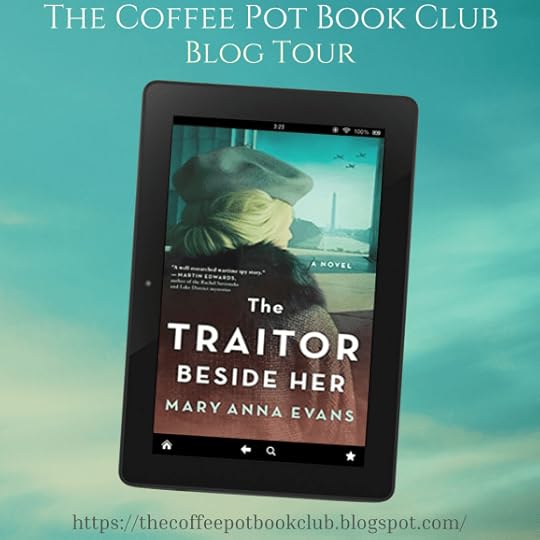 Mary Anna Evans’ Life As a Writer
Mary Anna Evans’ Life As a WriterA few years ago, I was speaking to the Institute for Learning in Retirement in my hometown, Hattiesburg, Mississippi. It was a large crowd of people who thought that retirement was great because it gave them more time to learn things. In other words, these were my kind of people.
I was asked the question, “How long have you been a writer?”
I paused a second to formulate an answer and two hands shot into the air. This was an interesting turn of events. Who were these people who wanted to answer my question for me?
As it turns out, they were my mother and my fourth-grade teacher, two people I might have expected to be attendees of the Institute for Learning in Retirement. They wanted to tell people that I’d always been a writer.
Had I? I’d certainly done other things with my life besides writing. I studied physics and engineering in college. I worked a good deal in those fields before I changed my focus to writing—spending a summer working offshore for an oil company, teaching math and physics for a couple of years right after graduate school and working as an environmental consultant at work that took me all over the country—but I do think my mother and Mrs. Kochtitzky were right.
I’ve always enjoyed writing, even when it was a fourth-grade history assignment. My affinity for writing has come in handy, even when I was working in the sciences because there is no substitute for an ability to communicate. My environmental firm’s only product was its reports. We didn’t make widgets. We gave our clients expert advice on difficult problems, and we did this in writing. A good engineer who can write well will likely have a successful career. I’ve spoken to math teachers about how to bring reading material into the classroom. I’ve even co-written articles and a book with a professor who specialized in such things.
No matter what turns my life takes, my livelihood always comes back to the written word. These days, I write novels. I work as a professor who teaches students how to write fiction and nonfiction. And I write books and articles about one of the most fascinating and successful novelists of all time, Agatha Christie. I love doing every single one of those things.
And apparently, my mother and Mrs. Kochtitzky knew I’d love it way back when I was in the fourth grade.
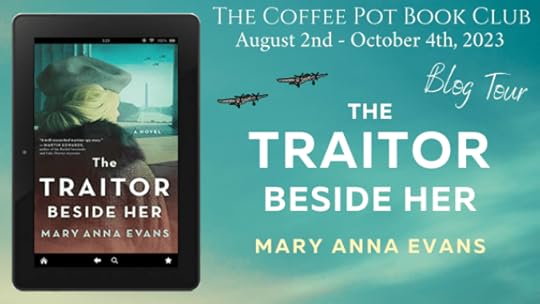
Justine Byrne can’t trust the people working beside her. Arlington Hall, a former women’s college in Virginia has been taken over by the United States Army where hundreds of men and women work to decode countless pieces of communication coming from the Axis powers. Justine works among them, handling the most sensitive secrets of World War II—but she isn’t there to decipher German codes—she’s there to find a traitor. Justine keeps her guard up and her ears open, confiding only in her best friend, Georgette, an affluent speaker of Choctaw who is training to work as a code talker. Justine tries to befriend each suspect, believing that the key to finding the spy lies not in cryptography but in understanding how code breakers tick. When young women begin to go missing at Arlington Hall, her deadline for unraveling the web of secrets becomes urgent and one thing remains clear: a single secret in enemy hands could end thousands of lives.
Universal Link: https://books2read.com/u/4XwxG1Amazon UK:https://www.amazon.co.uk/Traitor-Beside-Her-Novel/dp/1464215588Amazon
US: https://www.amazon.com/dp/B0BGYPLMTH
Amazon CA: https://www.amazon.ca/Traitor-Beside-Her-Novel/dp/1464215588
Amazon AU: https://www.amazon.com.au/Traitor-Beside-Her-Novel-ebook/dp/B0BGYPLMTH
Barnes and Noble: https://www.barnesandnoble.com/w/the-traitor-beside-her-mary-anna-evans/1143344440
Bookshop: https://bookshop.org/p/books/the-traitor-beside-her-mary-anna-evans/18743820
Audiobooks.com: https://www.audiobooks.com/audiobook/672506/Audible:https://www.audible.com/pd/The-Traitor-Beside-Her-Audiobook/B0BVDLCL7J
July 20, 2023
Book News: An Update For And Shadows Will Fall
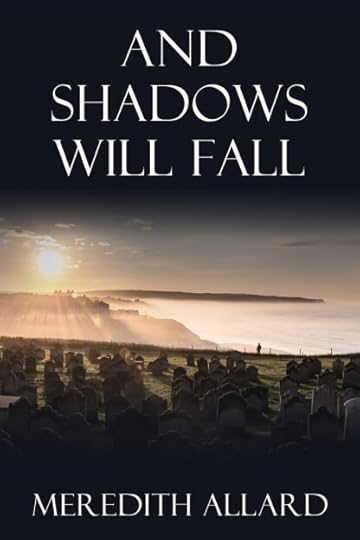 Another great cover from Jenny Q!
Another great cover from Jenny Q!While I’m on vacation this month, I thought I’d add some updates about And Shadows Will Fall. Originally, I included this in another post, but since I’m still getting questions I thought I’d repost it here.
Keep your questions coming. I love hearing from readers.
What About And Shadows Will Fall?In addition to reading as many books as I can and taking some time for myself this summer, I’ll also finish the next draft of And Shadows Will Fall. For those of you who have asked about a publication date, thank you.
As always, I’m terrible at guessing when books will be done. I’m cautiously optimistic that an Autumn 2023 publication date is in the cards. At the moment, it looks like ASWF will be a novella at about 30,000 words, but I won’t have a definite word count until the final edits are complete.
And Shadows Will Fall is Book Six in the Loving Husband Series, but as far as placement it belongs between Her Loving Husband’s Return and The Duchess of Idaho. I’d love to write my books in order, but I’ll take my inspiration where I can find it.
The story focuses on how James and Sarah deal with the changes James experienced in Her Loving Husband’s Return. True or false: the story was inspired by something a fan of the series said to me. If you guessed true, you are correct!
More than that would be spoilers!
June 28, 2023
What Is A Commonplace Book And Why Should You Keep One?
 What Is A Commonplace Book?
What Is A Commonplace Book?Lately, I’ve been seeing many posts about commonplace books. Once I discovered what commonplace books were, I was surprised I hadn’t kept one before. Then I realized that I have kept commonplace books, only I called them quote journals. Maybe you have too.
The simplest way to understand a commonplace book is to think of it as a receptacle of knowledge. A commonplace book is a handy-dandy place to keep your favorite quotes and passages from books, memes, movies, TV shows, and research. Perhaps a friend said something wise that you want to remember. You would write that into your commonplace book. A commonplace book is a place to record anything you find important.
Commonplace books have been kept for centuries. Some noteworthy people who kept commonplace books are Leonardo da Vinci, Thomas Jefferson, Samuel Taylor Coleridge, Mark Twain, and Virginia Woolf, among many others.
Using A Commonplace Book To Help With Writing ProjectsAs I’ve been reading about commonplace books, I thought the process of keeping such a journal might help me with my new book about writing. I’ve been working on this project for several months now, and I kept hitting a wall since there are a few moving parts that need to move in tandem in order for this book to work. On the one hand, the book is about how I learned to embrace the writing life. There are also aspects of spirituality, including mindfulness, as well as elements of slow living. While I had a general idea of what I was trying to accomplish, figuring out how the pieces fit together has been an interesting process, to say the least.
Commonplace books are not necessarily intended to help with certain projects. They are intended to be a place to explore ideas and keep information. Leonardo da Vinci’s commonplace book is a thing of wonder. But I decided that I could use the commonplace book as a way to help me gather my ideas for my book in one place. I had quotes, ideas, and information that I wanted to use scattered without rhyme or reason, so I decided to dedicate a commonplace book specifically as a receptacle for information for this particular book I’m writing.
My Process Of Keeping a Commonplace Book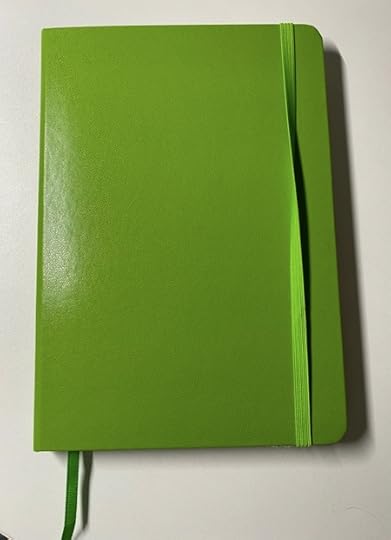
This is the book I’m using for my commonplace book. It’s a 5.7 x 8-inch dotted journal from Paperage that I purchased from Amazon. It came in a package of three. I bought it for bullet journaling, and I created two bullet journals that I used for research for The Duchess of Idaho. I’ll share the process of bullet journaling as a way to research historical fiction in a future post. At first, I wasn’t sure about the dots instead of lines, but I’ve come to like the dots since the dots give me more flexibility with how I use the page.
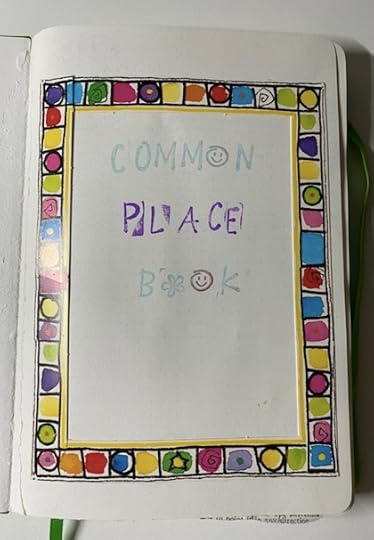
This is the title page of my book. When I originally decided to create a commonplace book, I thought I would make it a little crafty since there are many examples of crafty commonplace books. However, as I thought about it, I realized that I have my art journal and my junk journal for artistic expression, and if my intention for this commonplace book is to help me gather my thoughts for the book I’m writing, then getting crafty wasn’t necessary.
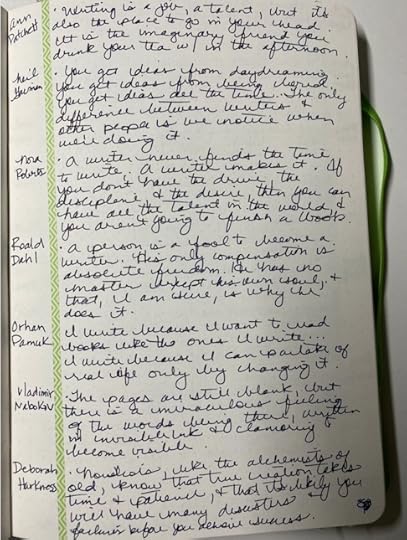
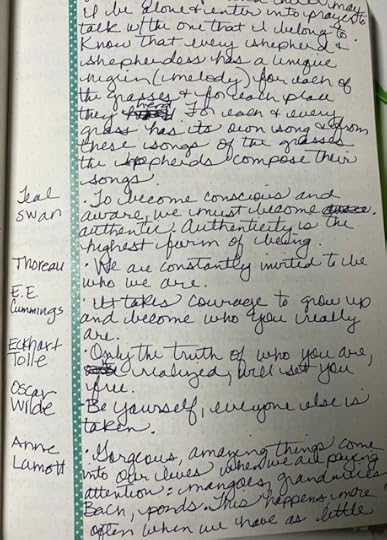
My one concession to creating a crafty commonplace book was using washi tape to create a left-side margin where I write the name of the person who said the quote or gave the information. You can see that the person’s name is to the left and their quote is to the right.
I haven’t organized the book in any way. I’ve been going through the notes I have scattered around my workspace and I’ve been adding them to the commonplace book as I find them. It seems like I find something new I want to add every day.
I have quotes from writers, spiritual teachers, rabbis, Brene Brown, artists, creatives, Julia Cameron, Tasha Tudor; really, a wide variety of sources. Now I have everything I want to consider for this odd little book I’m writing together in one journal. When I’m writing, I have my handy-dandy little green commonplace book at my side, and when I’m looking for a quote from Anne Lamott, for example, I know where to find it.
While the book itself isn’t organized in any certain way, having the names to the left of the page makes it easier for me to find that Anne Lamott quote. I have to skim the left-hand side of the pages to find the quote I’m looking for, but I think it’s easier than if I had written the names after the quotes inside the text.
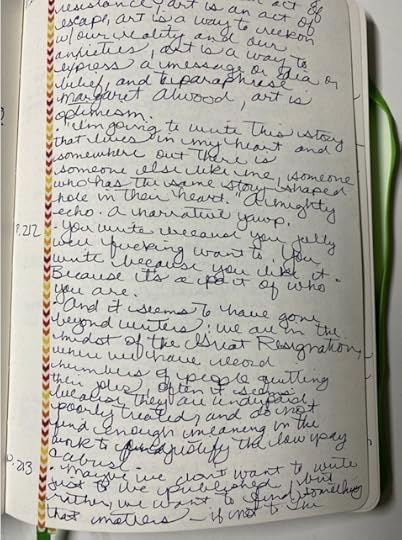
If I’m writing a number of passages from the same book, then I’ll write the author and the name of the book in the left-side margin, and then after that, I’ll add the page numbers where I found the quotes.
You don’t need to use a commonplace book specifically for a project as I am. You can keep a commonplace book with inspirational quotes that will help get you going when your motivation tank is running low. You can use it to doodle and work through ideas. You can keep a commonplace book as a place to keep interesting pieces of knowledge that you want to remember.
Why Keep A Commonplace Book?I watched an interesting video about commonplace books on YouTube by Robin Waldun where he discusses how commonplace books can boost our creativity. Waldun argues that since there aren’t many brand-new ideas, creativity happens when we look at what others have done before us. By studying what others have done, we can take what we learn from them and then make it our own. Creating a commonplace book gives us space where we can take information from others, study it, synthesize it, and learn from it. Afterward, we might have the knowledge to create something that is uniquely our own.
That’s so true in writing, isn’t it? There really aren’t any new stories to be told. But we learn from our influences and create a style all our own. Then we tell the stories the way only we can.
I’m so happy that I discovered the joys of keeping a commonplace book. Having all my research for my odd little book in one place makes writing that book much easier.



